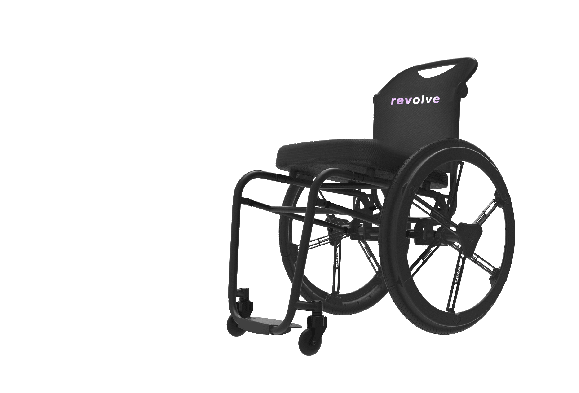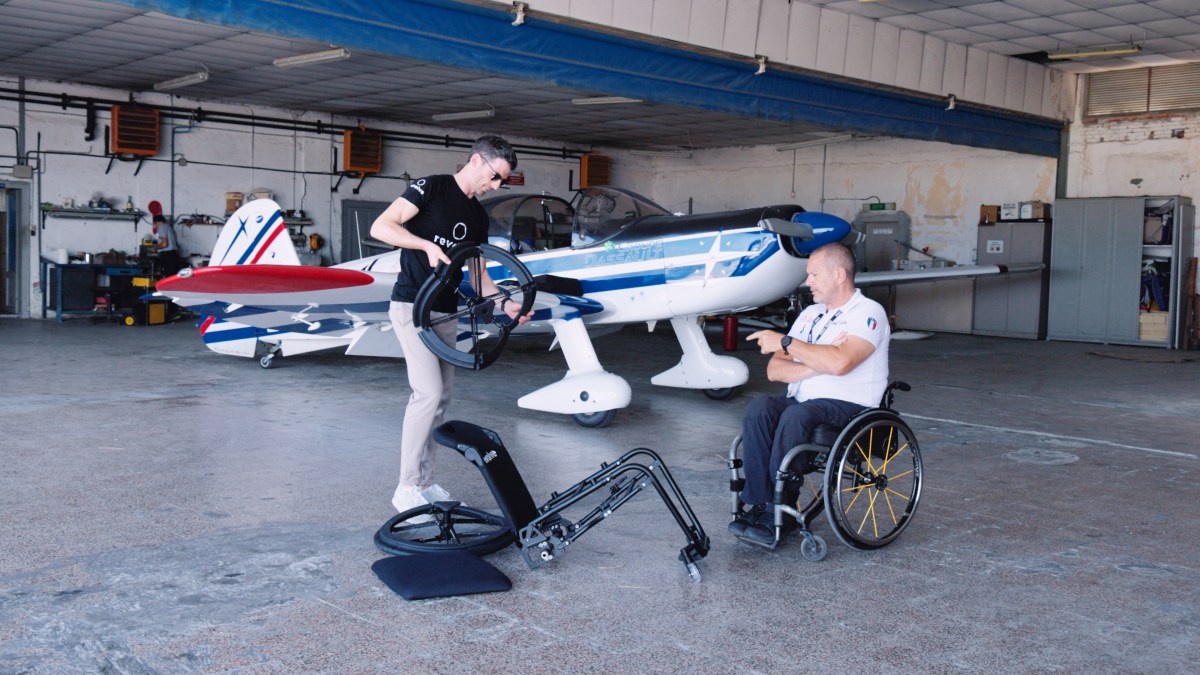Travel wheelchair Revolve Air launches on Kickstarter | TechCrunch
Revolve Air, a travel wheelchair that can fold to cabin-luggage size, is now available for preorders on Kickstarter at a cost of $4,999. Its future retail price is estimated at $7,500, although it could be lower depending on the success of the Kickstarter campaign.
Kickstarter CEO Everette Taylor wrote on LinkedIn he was “excited for [this] launch” — and he sounded so. While onstage at TechCrunch Disrupt last week, he namechecked Revolve Air’s creator Andrea Mocellin, whose startup was one of the Battlefield 200 finalists this year.
It’s not just Taylor who’s excited: Revolve already received support from Toyota and Allianz accelerators, as well as several accolades for its prototype. It was named one of TIME Magazine’s Best Inventions in 2021, and many people were curious to finally see it (unfold) in person during the conference.
The Revolve Air does have an undeniable “wow factor” — something you will rarely hear about a wheelchair. Its most attention-grabbing detail is that it’s not just the chair that’s foldable; the wheels are, too. In fact, that’s where it all began.
“Yes, we started with reinventing the wheel,” Revolve Mobility’s site reads.
Mocellin isn’t new to things on wheels; his track record in the automotive industry includes stints working on Ferraris and Maseratis. He’s also a former lead designer at electric jet company Lilium; mobility as a whole was his field, so when he came up with a foldable wheel design a few years ago, one of his most obvious options was to create foldable bikes. Instead, he ended up creating an innovative wheelchair.
“I didn’t have any background in the wheelchair market, but I wanted to design something to improve people’s life,” Mocellin told me. A cabin-sized wheelchair fits the bill, as a way to make travel much less inconvenient for wheelchair users. Instead of risking having their main wheelchair stored in the plane’s cargo hold while being transferred with a no-frills aisle chair, they can use the same wheelchair all along.

Image Credits: Revolve Mobility
There’s clearly some demand for the Revolve Air: When Mocellin started his pre-crowdfunding campaign, he received 12,000 requests in a matter of weeks. (These early declarations of interest guaranteed users a discount on the then-upcoming Kickstarter launch.)
Launching on Kickstarter is a prolongation of this direct-to-user strategy, but also a new approach to sales in disability tech. Mocellin thinks there’s something disruptive about letting users purchase the Revolve Air through Kickstarter instead of working with the usual distributors that sell medical devices. “It’s a way to spread what we want to achieve in revolutionizing inclusion accessibility.”
One thing is for sure, Revolve is pretty darn good at marketing and communication; the awards and media coverage it received before even launching are no accident. Nike is an example for the startup, not just because of its brand power, but also because of its “Just Do It” motto. “We want to be the Nike of wheelchairs, because we want to make everyone active,” Mocellin said.
It may take a while for Revolve Air to reach everyone, though; and its steep price tag will definitely be a blocker. The startup knows this, and replaced its British manufacturing partner with a Dutch one to reduce costs. But there is only as low as it can go without compromising quality.
High production standards are a must for the Revolve Air — because expectations are high at this price level, but also because of user requirements. When an early prototype received criticism for looking too flimsy or lacking certain features, Mocellin made sure to work on improvements to make his design more adapted to wheelchair users who may also need armrests, for instance.
The Revolve Air is still not the sturdiest wheelchair out there, and won’t be adapted to people above a certain weight threshold; there’s always a tradeoff when the design also needs to be compact and lightweight. The same goes with being foldable and not having a motor: It means that users will require external help unless they still have the power to use their arms. But that didn’t deter preorders, and from a broader audience than expected.
Mocellin was happy to notice that age, for instance, varies from 18 to 85. Perhaps it’s because people aren’t always ordering for themselves, but also for a child or a parent. Still, it goes to show that Revolve Air’s users may be more sedentary than its first endorsers — and that’s on purpose.
Indeed, you’ll notice from watching Revolve’s first videos that it enlisted highly active ambassadors with pretty impressive credentials, such as paralympic champions. Their role isn’t just to spread the word, though: They are also early testers.
“Every time we have an update, we meet with them, we record their testing and so on.” They will be among the first recipients of the final wheelchair model when it’s ready. But in the meantime, their testimonials are meant to inspire others.
“Our ambition is to use the power of these athletes and people who do extraordinary things, like aerobatic fighter pilots, to stimulate [other] users to come out and also do more of what they want in life [instead of not doing] it because their wheelchair doesn’t allow [them] to travel easily or to be independent. So that’s our effort [and] that’s why we have those testimonials.”
The ambassadors also helped the company unveil new use cases, from the businessman who could store the Revolve Air in his car trunk while going from meeting to meeting, to the light-plane pilot who could now fly one way, instead of having to come back to his departure point for his wheelchair.
Air travel, however, still sounds like the main use case for the Revolve Air. Despite the airlines’ and airports’ obligations to passengers, traveling with a disability is never easy, and wheelchairs too often get damaged during transport.
Unfortunately, it still seems unlikely that airports will buy Revolve Air wheelchairs in bulk just yet. For comparison, a foldable Breezy wheelchair like one I recently spotted in an airport retails for less than $200. Just like wheelchair users often end up paying for first class tickets, it looks like they will have to pick up the bill for a high-end active wheelchair, too.
“Assistive devices serve smaller markets with price-sensitive customers, making it difficult to achieve attractive economics. This is especially true for hardware products. As a result people with disabilities often pay a ‘disability tax’ for products that serve only the disability community,” a recent white paper from the Perkins School for the Blind noted.
But as we have eventually seen with other innovations, Revolve’s offering could hopefully go from premium B2C to more affordable B2C and B2B, too. Mocellin certainly hopes so. Future iterations, for instance, could be found in hospitals or available for rental. “I see Revolve Air as our first product as a brand, and then opening up more opportunities by also […] having a different product range in terms of pricing, user and customer.”
For now, though, this first goal is to fulfill orders from everyone who has already requested a Revolve Air or will do so via the Kickstarter campaign. The more that do so, the more chances Revolve will have to bring the Air’s final price tag down and eventually launch more products.



